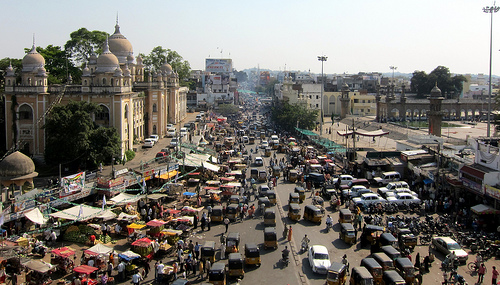![]() photo credit: indi.ca
photo credit: indi.ca
If livable cities give all citizens equal opportunity to lead healthy, comfortable and safe lives, how livable is our Hyderabad ? Here’s a citizen activist’s perspective.
Doctors prescribe half-an-hour walk everyday, among other things to stay healthy. For those who cannot afford the luxury of a gym, walking to offices is an option. How pedestrian-friendly are our Hyderabad streets? Fast food is fast becoming a pass time for children. How many outdoor choices can we show them in parks, municipal swimming pools and skating rinks? For teenagers who started relying on the Facebook for facing life’s challenges, what are the city avenues for adventure learning and sport facilities?
The footpath to road ratio is poor in Hyderabad and the walkability index is a mere 0.68, making it one of the worst cities in India for pedestrian friendliness. With 30 lakh vehicles plying, Hyderabad has the highest density of traffic in India. Vehicle to road length ratio is bad, respirable particulate matter (RPM) several notches above the acceptable levels, 50% of the road accident victims are pedestrians and billions of working hours are lost with people stuck in traffic. Captive walkers may not be walking by choice; they have no access to public transport!
My 65-year-old neighbour became healthy after a neighbourhood park appeared. He walks daily, made friends, does yoga and laughs his way to health. Studies on SROI (Social Return on Investment) show that parks also serve as instruments to forge communal, community bonding, resolve family conflicts, encourage informal official meetings reducing pollution.
KBR Park that has been put in the league of Central Park of New York and Hyde Park of London is accessible only to Jubilee Hills residents. The rest of the city has not been so lucky. With just 600 parks developed in an inequitable fashion for eight million, citizens are desperately waiting to see parks in the 2,200 open spaces meant for that purpose. Currently, most colonies house fenced open spaces with faded boards declaring GHMC’s ownership!
My maid who lives in a slum, fed up with contaminated water, disease burden and mounting medical bills asked me how much we pay for water. After quick calculations announced that she is willing to pay at the same rate! She just educated me about opportunity cost and her coping costs, technical term for lack of services and coping mechanisms used by the poor! In fact, all WTP (willingness to pay) studies prove that slums want basic services like water and sanitation and they are willing to pay for those. It is the government that is unwilling to charge!
With 1,485 slums and more being created, our city has to act fast or Hyderabad while legitimising the illegitimate may well morph into a mammoth slum! Is it just insipid institutions, defunct departments and procedural pains that are responsible for this state of affairs?
With a build-now, regularize-later culture, jurisdictional schizophrenia making a municipal ward nobody’s baby, multiplicity of agencies, conflicting executive and political interests, lake encroachments, lopsided development, rusted water pipes, gushing sewers, our greater city has to deal with systemic problems to get anywhere near livable status. Those, who expressed concern when Hyderabad became “greater” that it will have greater challenges of integration, providing equitable services and staying accountable to a larger population stand vindicated today! Why, the much hyped up Hi-Tech City has a maze of optic fibre lines, but sadly no sewerage lines!
Governance framework is partly responsible for this state of affairs. Hyderabad, though a metropolis now is still a state’s baby. Despite the 74th constitutional amendment Act, it is not the city but the state that decides the urban infrastructure projects, levies and collects taxes. The state also interferes with the local governments property tax by deciding the tax base, rates and modes of assessment leaving the city government disempowered and financially weak. Though JNNURM (Jawaharlal Nehru Urban Renewal Mission) aims to rectify that, shuttle negotiations with the state have been leading to delays and sub-optimal development of Hyderabad.
The City Development Plan of Hyderabad (CDP) that accessed the JNNURM funds for the city was sent without the mandatory stakeholder consultations. There is also a community participation law for urban projects just as there is a JNNURM framework for citizen participation. Citizens do not question enough. The government does not share enough. Town hall meetings that are the purest form of democratic governing are missing in our city. Citizens have to participate actively in city development. We must realize that managing cities is not just government business alone. It is ours too.
We can make Hyderabad a livable city if citizens wear a reformer hat to cleanse institutions, an activist hat to question investment decisions and a partner hat to accelerate equitable development!

